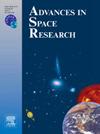IF 2.8
3区 地球科学
Q2 ASTRONOMY & ASTROPHYSICS
引用次数: 0
摘要
FY-4B 是中国发射的风云四号系列中的第一颗业务卫星。评估 FY-4B 静止干涉红外探测器(GIIRS)温度(T)和相对湿度(RH)剖面产品的精度对于中国静止卫星高光谱数据的进步和实际部署至关重要。本研究利用2023年1月16日至2024年1月16日的无线电探测仪数据,评估了FY-4B温度和相对湿度剖面产品相对于FY-4A的探测能力和精度。结果表明,FY-4B GIIRS 在晴朗天空下探测 T 的能力与 FY-4A GIIRS 相当。然而,FY-4A GIIRS 在多云条件下表现出更优越的性能。虽然 FY-4B GIIRS 能有效探测 RH,但其 RH 剖面产品的精度较低,偏差为 -3.89%,均方根误差为 15.42%,相关系数 (CC) 为 0.56。相比之下,FY-4B T 剖面产品的偏差为 -0.44 °C,均方根误差为 2.05 °C,相关系数为 0.89,表明与偏差为 -0.46 °C、均方根误差为 2.26 °C、相关系数为 0.87 的 FY-4A T 剖面产品相比,总体精度更高。尽管与无线电探空仪的测量结果总体偏差较小,但与无线电探空仪数据的相关性与站点高度成反比。值得注意的是,由于在 FY-4B 漂移之前,新疆的观测天顶角就已超过 60 度,因此在研究期间,卫星在新疆和西北部分地区晴朗天空下缺乏 T 和 RH 剖面产品。总体而言,FY-4A/B 的 T 剖面产品具有较高的精度,可有效解决偏远地区气象观测资料匮乏的问题。本文章由计算机程序翻译,如有差异,请以英文原文为准。
Accuracy evaluation of FY-4B GIIRS temperature and relative humidity profile products
FY-4B represents the first operational satellite within the Fengyun-4 series, launched by China. Evaluating the accuracy of the FY-4B Geostationary Interferometric Infrared Sounder (GIIRS) temperature (T) and relative humidity (RH) profile products is crucial for the advancement and practical deployment of China’s geostationary satellite hyperspectral data. This study assesses the detection capabilities and accuracy of the FY-4B T and RH profile products relative to FY-4A, utilizing radiosonde data spanning from January 16, 2023, to January 16, 2024. The findings indicate that the FY-4B GIIRS demonstrates comparable capabilities in detecting T under clear skies to the FY-4A GIIRS. However, the FY-4A GIIRS exhibits superior performance in cloudy conditions. While FY-4B GIIRS effectively detects RH, its RH profile products show less accuracy, with a bias of −3.89 %, an RMSE of 15.42 %, and a correlation coefficient (CC) of 0.56. In contrast, the FY-4B T profile product shows a bias of −0.44 °C, an RMSE of 2.05 °C, and a CC of 0.89, indicating an overall higher accuracy compared to the FY-4A T profile product, which has a bias of −0.46 °C, an RMSE of 2.26 °C, and a CC of 0.87. Despite their overall minor deviation from radiosonde measurements, the correlation with radiosonde data inversely correlates with station altitude. Notably, due to the observation zenith angle in Xinjiang exceeding 60 degrees even before FY-4B’s drift, the satellite lacks T and RH profile products in Xinjiang and parts of the northwestern region under clear skies during the study period. Overall, the T profile products from FY-4A/B exhibit high accuracy and effectively address the scarcity of meteorological observations in remote areas.
求助全文
通过发布文献求助,成功后即可免费获取论文全文。
去求助
来源期刊

Advances in Space Research
地学天文-地球科学综合
CiteScore
5.20
自引率
11.50%
发文量
800
审稿时长
5.8 months
期刊介绍:
The COSPAR publication Advances in Space Research (ASR) is an open journal covering all areas of space research including: space studies of the Earth''s surface, meteorology, climate, the Earth-Moon system, planets and small bodies of the solar system, upper atmospheres, ionospheres and magnetospheres of the Earth and planets including reference atmospheres, space plasmas in the solar system, astrophysics from space, materials sciences in space, fundamental physics in space, space debris, space weather, Earth observations of space phenomena, etc.
NB: Please note that manuscripts related to life sciences as related to space are no more accepted for submission to Advances in Space Research. Such manuscripts should now be submitted to the new COSPAR Journal Life Sciences in Space Research (LSSR).
All submissions are reviewed by two scientists in the field. COSPAR is an interdisciplinary scientific organization concerned with the progress of space research on an international scale. Operating under the rules of ICSU, COSPAR ignores political considerations and considers all questions solely from the scientific viewpoint.
 求助内容:
求助内容: 应助结果提醒方式:
应助结果提醒方式:


